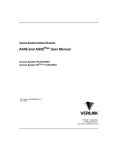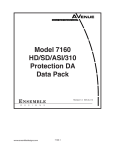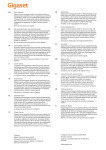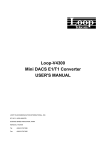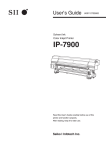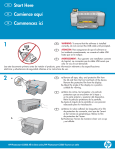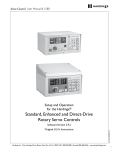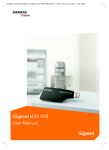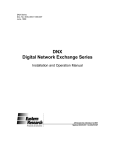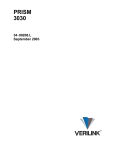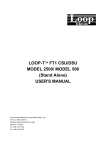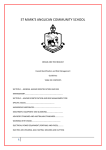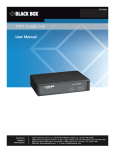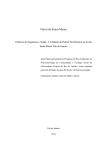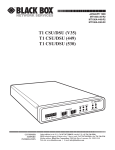Download Access System Centum Series User Manual
Transcript
Access System Centum Series User Manual Access System 100 Single Port CSU/DSU Access System 150 Drop-and-Insert Single Port CSU/DSU Access System 200 Dual Port CSU/DSU Part Number 896-502379-001-A March 1995 Verilink Corporation 145 Baytech Drive San Jose, California 95134 Important Notice VERILINK CORPORATION DISTRIBUTES THIS REFERENCE “AS IS” WITHOUT WARRANTY OF ANY KIND, EITHER LIMITED OR IMPLIED. Verilink Corporation reserves the right to revise this publication from time to time without notice. Some states or jurisdictions do not allow disclaimer of express or implied warranties in certain transactions; therefore, this statement may not apply to you. Copyright 1995 Verilink Corporation. All rights reserved. Your right to copy this manual is limited by copyright law. Making copies of this reference, or any part thereof, without prior written authorization fromVerilink Corporation is prohibited by law and constitutes a punishable violation of the law ii Access System Centum Series User Manual Unpacking This equipment is normally shipped in cardboard cartons with foam inserts to protect the units from shock and vibration during shipment. Upon arrival of the equipment, inspect the condition of the boxes and compare all items to the packing list. Notify Verilink and the carrier immediately if there are any damages or shortages. Store the cartons and packing material in case the unit has to be shipped at a later date. WARNING The following rules should always be followed when connecting telephone equipment and/or wiring: 1. Never install telephone wiring during a lightning storm. 2. Never install the telephone jacks in wet locations unless the jack is specifically designed for wet locations. 3. Never touch uninsulated telephone wires or terminals unless the telephone line has been disconnected at the network interface. 4. Use caution when installing or modifying telephone lines. NOTE Verilink reserves the right to incorporate product enhancements and/or change product specifications at any time and without notice. Warranty All Verilink equipment is covered by a 5-year new product warranty. For additional information, call 1.800.VERILINK. Access System Centum Series User Manual iii FCC Information This equipment complies with the requirements in Part 15 of FCC Rules for a Class A computing device. Operation of this equipment in a residential area may cause unacceptable interference to radio and television reception, requiring the operator to take whatever steps are necessary to correct the interference. Verilink shielded cables should be used with this unit to ensure compliance with the Class A limits. This equipment meets the technical criteria specified in the Part 68 rules, sub-part A through F, (for connection of terminal equipment to the telephone network) as well as the requirements specified inAT&T Technical Publications 62411, 54016, and 54019A (ESF). This equipment meets the safety requirements of the Underwriters’ Laboratories (UL) technical publications UL 1950. iv FCC Registration # 2J3USA-75166-DE-N Type of Interface 1.544 Mbps Digital Channel Facility Interface 04DU9-B for D4 format 04DU9-C for ESF format with AMI Line Code 04DU9-S for ESF format with B8ZS Line Code Service Code 6.0N Jack Arrangement RJ-48C Ringer Equivalence N/A Access System Centum Series User Manual FCC User Requirements The following instructions are provided to ensure that you comply with the Federal Communications Commission (FCC) Rules, Part 68: 1. All direct connections to the T1 digital lines must be made through standard plugs and jacks furnished by the telephone company. no connections can be made to party lines or coin lines. Before connecting your unit, you must do the following: a. Tell your local telephone company that you have an FCC registered device that you wish to connect to the company’s lines. Provide the 14-digit FCC registration number listed on the label. The telephone company will also need to know the facility interface code (04DU9-B) and service code (6.0N) in order to connect the necessary service. b. Inform the telephone company that you wish to use the RJ-48C jack arrangement. c. After the telephone company has installed the RJ-48C jack, you may connect the CSU with the appropriate cable. 2. If the unit appears to be malfunctioning, it should be disconnected from the telephone line until the source of the problem is confirmed. If the unit needs repair, it should not be reconnected until after the repair is completed. 3. The CSU has been designed to prevent harm to the DDS or T1 network. IF the telephone company determines that it is exceeding tolerance parameters, they are permitted to temporarily disconnect service. When possible, the customer will be given advance notice. 4. Under FCC Rules, no customer is authorized to repair the equipment, regardless of its warranty status. 5. If the telephone company alters the equipment in a manner that will affect its usage, advance notice must be given to prevent service interruption. Normally,Verilink CSU equipment will be used to interface either FCC registered or grandfathered digital terminal equipment to the digital service channel. If the equipment to be connected is not of this type, institutional procedures provide that an affidavit be supplied to the Access System Centum Series User Manual v telephone company. This affidavit must state that the system will be operated only by trained individuals and that the signal power at the telephone company interface will not exceed the limits set forth in Part 68 of the FCC’s Rules and Regulations. vi Access System Centum Series User Manual Table of Contents Introduction ................................................................................................................................ 1-1 T1 Concepts ...................................................................................................................... 1-1 Product Features and Specifications ................................................................................. 1-2 Special Centum Series Features ............................................................................ 1-2 Built-in T1 ESF CS .............................................................................. 1-2 Network Protection ................................................................................. 1-2 Front Panel Control ................................................................................ 1-2 Terminal Control .................................................................................... 1-3 NMS Control .......................................................................................... 1-3 Printer Support ........................................................................................ 1-3 Event Log ............................................................................................... 1-3 Built-in Diagnostics ................................................................................ 1-3 ESF Operation ........................................................................................ 1-4 Clear Channel ......................................................................................... 1-4 Specifications ........................................................................................................ 1-4 Front Panel Overview ................................................................................................................. Introduction ...................................................................................................................... LCD Screen ...................................................................................................................... LED Indicators ................................................................................................................. 2-1 2-1 2-3 2-5 Configuring and Installing the Centum Series ............................................................................ 3-1 Requirements .................................................................................................................... 3-2 Software and hardware ......................................................................................... 3-2 Power and environmental ..................................................................................... 3-2 Centum Series Worksheet ................................................................................................ 3-2 Configuration Parameters ................................................................................................. 3-4 Checking the “T-Channels” ............................................................................................ 3-18 Self-Testing Centum Series ............................................................................................ 3-20 Connecting the Centum Series ....................................................................................... 3-22 Line Testing (Point-to-Point Configuration) .................................................................. 3-24 Line Testing (Integrated Access, Fractional T1) ............................................................ 3-26 Testing the Centum Series ......................................................................................................... 4-1 CSU Loop ......................................................................................................................... 4-2 Access System Centum Series User Manual vii Payload BERT .................................................................................................................. 4-3 CSU Loop with BERT ..................................................................................................... 4-5 Payload Loop .................................................................................................................... 4-6 Line Loop ......................................................................................................................... 4-7 DSX-1 Loop ..................................................................................................................... 4-9 Serial Port Loop ............................................................................................................. 4-10 Serial Port BERT ............................................................................................................ 4-12 Other Features ........................................................................................................................... Alarms and Statistics ........................................................................................................ Alarm Definitions ................................................................................................. ESF Statistics Definitions ..................................................................................... Alarms/Statistics Menu .................................................................................................... Utilities ............................................................................................................................. Events ............................................................................................................................... Event Printing ................................................................................................................... 5-1 5-1 5-1 5-2 5-3 5-5 5-6 5-7 Auxiliary Ports ........................................................................................................................... 6-1 Cabling ............................................................................................................................. 6-2 Auxiliary ports ...................................................................................................... 6-3 Modular Adapters ............................................................................................................. 6-4 Rear panel views ................................................................................................... 6-4 Terminal Configuration .................................................................................................... 6-6 Terminal Operation .......................................................................................................... 6-8 Configuration Menus ........................................................................................................ 6-9 Serial Port Diagnostics ................................................................................................... 6-11 Link Alarms and Statistics ............................................................................................. 6-12 ESF Registers ................................................................................................................. 6-13 Event Log ....................................................................................................................... 6-15 Utilities ........................................................................................................................... 6-16 Printer Configuration ...................................................................................................... 6-17 Printer Port Flow Control ............................................................................................... 6-18 Printer Operation ............................................................................................................ 6-19 Link Alarms and Statistics ............................................................................................. 6-20 SNMP Management ................................................................................................................... Connecting the Centum Series ........................................................................................ Option #1 ............................................................................................................. Option #2 ............................................................................................................. Compiling the Centum Series MIB ................................................................................. A-1 A-1 A-1 A-3 A-4 Standard Cabling for User Ports ................................................................................................. B-1 viii Access System Centum Series User Manual Network Interface and DSX-1 Port ................................................................................. B-1 V.35 Serial Port ............................................................................................................... B-2 RS-442A Serial Port ........................................................................................................ B-3 Special Serial Port Cabling ........................................................................................................ External Timing ............................................................................................................... Cables for External Timing ............................................................................................. V.35 Serial Port Cabling ...................................................................................... RS-422A Serial Port Cabling ............................................................................... Cables for Internal/External Timing ................................................................................ Access System Centum Series User Manual C-1 C-1 C-2 C-2 C-3 C-5 ix x Access System Centum Series User Manual List of Figures Figur e2-1 Figur e2-2 Figur e2-3 Figur e2-4 Figur e3-1 Figur e3-2 Figur e3-3 Figur e4-1 Figur e4-2 Figur e4-3 Figur e4-4 Figur e4-5 Figur e4-6 Figur e4-7 Figur e6-1 Figur e6-2 Figur e6-3 Figur e6-4 Figur eA-1 Figur eA-2 Figur eA-3 Figur eB-1 Figur eB-2 Figur eC-1 Figur eC-2 Figur eC-3 Figur eC-4 Front Panel: Access System 100 (AS100) Single Port CSU/DSU ...............................2-1 Front Panel: Access System 150 (AS150) Drop-and-Insert Single Port CSU/DSU ....2-1 Front Panel: Access System 200 (AS200) Dual Port CSU/DSU .................................2-2 Basic Centum Series Menu Tree .................................................................................. 2-4 Rear Panel of Access System 100 (V.35 version) ...................................................... 3-22 Rear Panel of Access System 150 (V.35 version) ...................................................... 3-22 Rear Panel of Access System 200 (V.35 version) ...................................................... 3-23 Payload BERT diagram ................................................................................................ 4-4 CSU Loop with BERT .................................................................................................. 4-5 Payload Loop diagram .................................................................................................. 4-6 Line Loop diagram ....................................................................................................... 4-8 DSX-1 Loop diagram ................................................................................................... 4-9 Serial Port Loop diagram ............................................................................................ 4-11 Serial Port BERT and Loop diagram .......................................................................... 4-13 6-Pin Modular Adapter Pin Assignments ..................................................................... 6-4 Rear Panel of Access System 100 (V.35 version) ........................................................ 6-4 Rear Panel of Access System 150 (V.35 version) ........................................................ 6-5 Rear Panel of Access System 200 (V.35 version) ........................................................ 6-5 SNMP Manager access with a terminal server ............................................................ A-2 SNMP Manager access with a router ........................................................................... A-2 SNMP Manager access via direct or dial-up connection ............................................. A-3 Network Interface and DSX-1 Port (RJ-48) ................................................................ B-1 V.35 Serial Port Pin Assignments (M-series, 34-pin connector) ................................. B-2 V.35 Serial Port #1 Cabling for External Timing ........................................................ C-2 RS-422A Serial Port #1 Cabling for External TIming ................................................ C-3 V.35 Serial Port #1 Cabling for Internal/External Timing .......................................... C-6 RS-422A Serial Port #1 Cabling for External TIming ................................................ C-7 Access System Centum Series User Manual xi xii Access System Centum Series User Manual Chapter 1 Introduction Verilink’s Access System Centum Series consists of the following three models: ■ ■ ■ Access System 100 Single Port CSU/DSU (AS100) Access System 150 Drop-and-Insert Single Port CSU/DSU (AS150) Access System 200 Dual Port CSU/DSU (AS200) Verilink’s Centum Series units integrate the capabilities of a T1 ESF CSU (Channel Service Unit) and DSU (Data Service Unit) in a single unit. Engineered with either aV.35 or RS-449 serial port, each unit provides high bandwidth for LANs, image transmission, mainframe file transfers, and other high-speed, synchronous applications. Additionally, the Access System 150 has a DSX-1 port to handle voice transmissions for drop-and-insert applications. T1 Concepts A T1 digital transmission facility carries twenty-four 64 kbps DS-0 channels, for a total of 1.536 Mbps (plus 8 kbps overhead to achieve the well-known 1.544 Mbps). These DS-0s can be demultiplexed by the Centum Series, and a group of DS-0s can be assigned to the connectors on the equipment to transport information. In some cases, the user has access to the full 64 kbps per channel while, in other cases, the limit is 56 kbps per channel. A detailed explanation is provided in Chapter 3, Configuring and Installing the Centum Series. The T1 facility itself can be a physical point-to-point circuit with all 24 DS-0s going from one site to another. The facility can also be an “Integrated Access” that uses a Central Office DACS and one or more Fractional T1 (FT1) links. This is a physical multipoint facility with logical point-to-point links formed by groups of DS-0s. Access System Centum Series User Manual 1-1 Product Features and Specifications This section explains product features and specifications. Special Centum Series Features The Centum Series has a number of special features. Built-in T1 ESF CSU Interfacing to T1 or Fractional T1 services requires a T1 CSU (Channel Service Unit). The Centum Series includes a built-in T1 ESF CSU as standard equipment. The superior ESF (Extended Superframe) CSU includes provisions for continuous performance monitoring by both the user and the telephone company central office. ESF provides a 4 kbps link control channel (transparent to user data) which allows the telephone company to monitor the local loop, transmit and receive test messages and retrieve performance data, all without interrupting normal operations. Network Protection The Centum Series provides complete electrical protection for the network by automatically inserting pulses into the transmitted signal as required to meet the bit density formula specified in AT&T Pub 62411. Front Panel Control The Centum Series is easy to use. Configuration and testing are accomplished with a few buttons. Status is shown on a 32-character liquid crystal display (LCD) screen and 10 front-panel indicators. The LCD screen serves as a “window” that can be moved vertically. The indicators are separated in NI (Network Interface) and serial (DTE) port groups. 1-2 Access System Centum Series User Manual Terminal Control All Centum Series features can be accessed via an external terminal. The terminal’s CRT allows displays that are much more comprehensive than possible via the front panel LCD. The user-supplied terminal can be selected from a wide variety of standard offerings or can be a PC with terminal emulation software. NMS Control Configuration, dialing, and testing can also be controlled through a usersupplied PC using the optional Verilink SNMP-based network management software. Most DOS-based PC devices can serve as the NMS (Network Management System) console. The console port on the rear panel of the Centum Series, an RS-232C connector, supports speeds of 1200, 2400, 4800, and 9600 bps. A password routine prevents unauthorized access to the NMS console screens. Printer Support The Centum Series includes a port for serial printer support. Real-time reports of all system events are automatically sent out this port. In addition, the front panel or an externally attached terminal can command printouts of configuration, alarms, and ESF statistics. Event Log The Centum Series constantly monitors for the occurrence of events, such as alarms, test commands, and system resets. When an event occurs, a description with a time and date stamp is immediately sent out the printer port. In addition, the Centum Series maintains a log of the most recent sixteen events and that log can be accessed by either the front panel controls and LCD panel or an externally attached terminal. Built-in Diagnostics Verilink’s Centum Series includes extensive capabilities to help pinpoint network problems without the need for external test equipment. Diagnostics include local and remote Serial Port digital loopbacks, LLB, RLB, and payload NI loopbacks. Access System Centum Series User Manual 1-3 The Centum Series also includes a built-in bit error rate tester (BERT), eliminating the need for external test equipment. The built-in tester transmits a 511-bit pseudo random test pattern. The Centum Series records errors received, seconds in test, and error-free seconds. Alarm conditions are displayed on the front panel LCD screen as well as on the console’s Alarms/Statistics screen. Front panel LEDs indicate unit and control signal status. ESF Operation Centum Series Extended SuperFrame (ESF) operation allows the telephone company central office to continuously monitor the local loop, to transmit and receive test messages, and to retrieve performance data, without interrupting normal operations. The unit is compatible with both AT&T 54016 and ANSI T1.403 specifications. Clear Channel The Centum Series provides clear channel signalling with B8ZS line coding (in installations where it is supported by the Telco central office) or alternate channel assignment. Specifications 1-4 Product specifications for the Centum Series are listed on the following page. Access System Centum Series User Manual AS100 AS150 AS200 ✔ ✔ ✔ ✔ ✔ 56/64 kbps where N = 1 to 24 E Synchronous CCITT V.35,EIA RS-422A/530, or A RS-422A/449 with optional adapter male 34-pin “M-series”, 25-pin “D”, or 37-pin “D” (with optional adapter) 44 Mbps olar B8ZS/AMI and ESF/D4 male 8-position RJ-48C ESF/D4 compatibility per AT&T Tech Pubs 62411, 54019, and ANSI T1.403 44 Mbps ± 50 bps, bipolar B8ZS or AMI 5, 15, 22.5 dB male 8-position RJ-48C rnal quency locked to NI (Repeater) quency locked to synchronous Serial Port #1 quency locked to DSX-1 Port l drive to 6000 feet al Digital Loopback mote Digital Loopback (V.54) al CSU Loopback, LLB, RLB, Payload Loopback work Interface and Serial Port with bidirectional testing, ctable patterns of “511”, 2047, “1 in 8”, “2 of 16”, and “All Ones” sity, Loop, BPV, Alarm sity, Loop, BPV, Alarm , Loop, DCD , Loop, DCD character Liquid Crystal Display (LCD) with front panel buttons CII terminal rm printer W x 1.75” H x 10” D ounds (maximum) letop or Rack 130 Vac, 57-63 Hz 40 degrees C, 90% humidity (non-condensing) Access System Centum Series User Manual 1-5 1-6 Access System Centum Series User Manual Chapter 2 Front Panel Overview Introduction The front panel LCD screen displays two rows of sixteen characters each. Menu parameters are presented individually. The buttons to the right of the LCD screen scroll data vertically through the screen, displaying up to two parameters at a time. There are also up to 10 LED indicators that are used to display the status of various Centum Series conditions. Figure 2-1 LED indicators Front Panel: Access System 100 (AS100) Single Por CSU/DSU LCD screen LED indicators UP and DOWN arrow buttons — to move to a field SELECT button — to choose a parameter or activate a function END button — to return to next higher menu grouping Figure 2-2 Front Panel: Access System 150 (AS150) Drop-andInsert Single Port CSU/DSU Access System Centum Series User Manual 2-1 Figure 2-3 Front Panel: Access System 200 (AS200) Dual Port CSU/ DSU There are two UP/DOWN (arrow) buttons, a SELECT button, and an END button. The basic operating procedures are simple. 1. To select a menu, use the UP and DOWN buttons to move to the desired field. 2. Then, SELECT to choose the submenu. 3. To choose from a particular set of parameters or activate a function, use the SELECT key. Use END to return to the next higher menu grouping. UP/DOWN (Arrow) Buttons. These buttons are used to move the display window vertically within a menu grouping. The UP button moves the display window up (backwards). The DOWN button moves the display window down (forward) to the next menu entry. SELECT .Used to choose a submenu, choose a parameter activate a function. END. 2-2 Used to return to the previous menu. Access System Centum Series User Manual LCD Scree The LCD screen is limited to two lines of 16 characters each. The displayed menus include the Main Menu, which is sub-divided into the following five (5) menus: Configuration, Diagnostics, Alarms & Statistics, Event Log, and Utilities. Each sub-menu is further broken down into sub-level menus. Menu examples are shown below. Subsequent chapters give detailed information regarding these menus. Main Menu HH:MM _Configuration NI Configuration Framing: _ESF Port 1 Diag. Local Loop: _On Access System Centum Series User Manual 2-3 Configuration Diagnostics Alarms / Stats Event Log Utilities NI Configuration NI & DSX-1 Loops & BERT NI Alarms Entry #1 Set Time & Date DSX-1 Configuration Serial Port #1 Loops & BERT DSX-1 Alarms Entry #2 Edit Unit ID MicroConnecT1 Timing Serial Port #2 Loops & BERT ESF Statistics Entry #3 Clear BRAM Serial Interfaces Print Alarms Display DS-0 Assignments Print Statistics Print Configuration Display S/W Revision Level Entry #16 Clear Log Configure Auxiliary Ports Basic Centum Series Menu Tree Access System Centum Series User Manual Figure 2-4 2-4 Main Menu LED Indicators There are up to ten LED indicators on the front panel. The actual quantity differs with the Centum Series model. They are used to indicate the status of various alarm and call conditions. They monitor three areas of Centum Series operation: DSX-1, Network Interface (NI) and Serial Channels. DEN (Network Interface). Indicates that the Network Interface is forcing the required number of transmitted “ones” to satisfy the T1 network requirements. This could be a result of improper configuration or failure of the customer’s attached Serial port equipment and will result in data corruption. ON when receive alarm condition (Red, Yellow, etc.) is detected on the DSX-1 Port. AL (DSX-1 Port). LP (DSX-1 Port & Network Interface). ON when either the Network Interface or the DSX-1 Port is in a loopback state. BPV (Network Interface) ON when Bipolar Violations are being received from the network. Can also indicated a very weak or overly strong signal. AL (Network Interface). ON when receive alarm condition exists (Red, Yellow, etc.) TST (Serial Port Channel 1). Indicates the status of the BERT test if in progress. Will be ON only if the test results are good. ON when a loop condition exists in the serial port either at the local or remote end. LP (Serial Port Channel 1). DCD (Serial Port Channel 1) ON when the state of the Data Carrier Detect (or equivalent) lead being transmitted to the DTE connected to the serial port is ON or HIGH. TST (Serial Port Channel 2). Indicates the status of the BERT test if in progress. Will be ON only if the test results are good. ON when a loop condition exists in the serial port either at the local or remote end. LP (Serial Port Channel 2). Access System Centum Series User Manual 2-5 DCD (Serial Port Channel 2) ON when the state of the Data Carrier Detect (or equivalent) lead being transmitted to the DTE connected to the serial port is ON or HIGH. 2-6 Access System Centum Series User Manual Chapter 3 Configuring and Installing the Centum Series WARNING The following rules should always be followed when connecting telephone equipment and/or wiring: 1. Never install telephone wiring during a lightning storm. 2. Never install the telephone jacks in wet locations unless the jack is specifically designed for wet locations. 3. Never touch insulated telephone wires or terminals unless the telephone line has been disconnected at the network interface. 4. Use caution when installing or modifying telephone lines. NOTE Centum Series units should not be connected to the network until after it has been completely configured and has successfully passed self test. Access System Centum Series User Manual 3-1 Configuring and Installing the Centum Series Requirements Listed below are the requirements for operating Centum Series units. Software an hardware Each Centum Series product is a self-contained unit that can be configured with no additional software or hardware. This chapter describes the steps necessary to configure, test, and install Centum Series using the front panel buttons and LCD panel. The same steps can be more easily performed using a customer-supplied external terminal (or PC with terminal emulation software). See Chapte r6, Auxiliary Ports, page 6-8. Power and environmental Centum Series uses 110-120 VAC, 60 Hz, at 0.25 amps. Centum Series does not require a conditioned environment but should be operated in areas with adequate ventilation. Centum Series Workshee 3-2 Access System Centum Series User Manual Centum Series Worksheet Access System Centum Series User Manual 3-3 Centum Series Worksheet T-Channel Definitions Serial Port #1 1 Data Rate: 13 First DS-0: 14 2 Alt/Consecutive: 2 CD Handling: Data Norm/Inv: 3 3 3 Clock Norm/Inv: Clocks: Remote Loop: T-Channel Number 14 15 16 Serial Port 1 Serial Port 2 DSX-1 Not Used 14 21 27 27 DS0-1 DS0-2 DS0-3 17 18 19 DS0-4 DS0-5 DS0-6 DS0-7 DS0-8 Serial Port #2 ce Data Rate: First DS-0: 21 Alt/Consecutive: 4 5 7 8 CD Handling: Data Norm/Inv: Clock Norm/Inv: Clocks: Remote Loop: 21 22 23 24 25 26 9 DS0-12 DS0-13 DS0-14 DS0-15 DS0-16 DS0-17 DS0-19 DSX-1 Interface DS0-20 Framing: 27 DS0-21 Line Code: 28 DS0-22 29 DS0-23 30 DS0-24 Distance: 12 DS0-11 DS0-18 10 11 DS0-10 DSX-1 CFA: 3-4 Centum Series Worksheet Access System Centum Series User Manual 6 DS0-9 20 Configuration Parameters Configuration Parameters Proper configuration of the Centum Series requires information regarding the network itself and the manner in which the network will be used. Most of this information is readily available from the network supplier although some user decisions must be made from within the limitations of the network. This manual includes a configuration worksheet on page 3-2 to aid the user in configuring the Centum Series. Verilink recommends that the master worksheet be photocopied and that copies be used to record the actual information for Centum Series units. By using the information in this chapter, one worksheet should be completed for each unit in the network. After completing all worksheets for all units, this chapter should again be used to actually configure the units. Note that the Centum Series can remain unpowered indefinitely without losing the configuration parameters. Plug in the Centum Series and confirm that the LCD panel displays: Main Menu HH:MM _Configuration If necessary, press the UP or DOWN arrow buttons until the panel displays the above information. Now, refer to a photocopied configuration sheet. The item numbers below correlate to the reference numbers circled on the sheet. 1. Model number Administration information indicating specific Centum Series model being configured. 2. Company name and location. Administrative information determined by customer. Access System Centum Series User Manual 3-5 Configuring and Installing the Centum Series 3. T-Carrier ID, Local Circuit ID, and Billing Number. Administrative information obtained from the network supplier SELECT to display: SELECT to display: Configuration _NI Interface Configuration Framing:_XX 4. NI Framing. This information must be obtained from the network supplier. Repeatedly SELECT to choose between D4 and ESF. DOWN to display: NI Configuration Line Code:_XXX 5. NI Line Code. This information must be obtained from the network supplier. Repeatedly SELECT to choose between AMI and B8ZS. DOWN to display: NI Configuration LBO..:_X dB 6. NI LBO. Should be set to 0 dB unless the network supplier specifically requests otherwise. If requested, repeatedly SELECT to choose 0, 7.5, 15, or 22 dB. 3-6 Access System Centum Series User Manual Configuration Parameters DOWN to display: NI Configuration NTWK Diag.: XXX 7. Network Diagnostics. This entry determines the Centum Series’ ability to respond to diagnostic commands received from the network supplier. Repeatedly SELECT to choose between Yes and No. User equipment must always respond to network-generated diagnostic commands. Select Yes unless the commands are to be passed to another T1 device that will respond. DOWN to display: NI Configuration Density: XXXX 8. NI Density. This information must be obtained from the network supplier. Repeatedly SELECT to choose Clear or 62411. A Clear network imposes no “ones density” requirements on the user. A 62411 network complies with AT&T Technical Reference #62411 and limits Centum Series transmission to no more than fifteen consecutive zeroes. If the Line Code entry (item #5, above) is B8ZS, choose Clear. If the Line Code entry is AMI, choose 62411. DOWN to display: NI Configuration NI CFA:_XXX 9. NI CFA. Repeated SELECT to choose between Yes and No. Yes causes Centum Series to discard data and send a “yellow alarm” if it is in a “red alarm” condition for three seconds. Access System Centum Series User Manual 3-7 Configuring and Installing the Centum Series Yes MUST be chosen if the network supplier is a common carrier, such as a telephone company. If the network is private, the selection is a user option. DOWN to display: NI Configuration ESF Frmt:_XXX 10. ESF Reporting Format. This entry describes the types of ESF network commands that the Centum Series will respond to. It has no meaning for D4 networks: see Framing (item #4, above). With ESF networks, this information must be obtained from the network supplier. Repeatedly SELECT to choose between AT&T Technical Reference 54016 and ANSI specification T1.403. DOWN to display: NI Configuration Clear Regs:_XXX 11. Clear Registers. Repeatedly SELECT to choose between Yes and No. Yes is the recommended choice. When commanded by the network supplier, Centum Series will transmit stored error information to the supplier. A Yes entry will cause Centum Series to clear all error counts when the unit is powered down and back up again. A No entry will allow potentially invalid registers in preparation for transmission to the network supplier. 3-8 Access System Centum Series User Manual Configuration Parameters to display: Configuration _NI Interface DOWN to display: NI Configuration _Timing Source 12. Timing Source. Repeatedly SELECT to choose NI, Port 1, Int, or DSX-1. In an Integrated Access, Fractional T1 environment, ALL units must use NI timing. In a point-to-point configuration, one unit must use NI timing and the other unit must use something else. This “something else” is nearly always Int (Internal) but some user configurations require Port 1 or DSX-1 timing. Contact the Technical Assistance Center if assistance is needed. to display: NI Configuration _Timing Source Access System Centum Series User Manual 3-9 Configuring and Installing the Centum Series NOTE Steps 13 through 19 apply to Serial Port #1 while the identical Steps20 through 26 apply to Serial Port #2. Main Menu, /DOWN to display: LECT and UP/DOWN Main Menu HH:MM _Configuration Configuration to display: _Serial Port #1 (or 2) SELECT to Serial Port #1 (or 2) display: _XXXK (XDS0) 13. Serial Port #1 Data Rate. [20. Serial Port #2 Data Rate] NOTE In an Integrated Access, Fractional T1 environment, this selection MUST be coordinated with the network supplier. Before entering a value, the user must first determine if each DS0 will carry 56 kbps or 64 kbps user data and must then determine the correct quantity of DS0s necessary to achieve the desired data rate. See Density (item #8, above). If the NI is Clear, the 56/64 decision is completely user optional and 64Kbps is recommended to obtain maximum data transfer efficiency in the network. 3-10 Access System Centum Series User Manual Configuration Parameters If the NI is not Clear, steps must be taken to ensure the proper “ones density” in the data presented to the network. If this is not done, Centum Series may occasionally damage user data in order to satisfy network requirements. There are three methods that can be used to ensure ones density in the data: • Limit the user data to 56 kbps per DS0. Centum Series will use the remaining 8 kbps (in each DS0) to provide the required density. • Allow 64 kbps user data in each DS0 and use alternate DS0s. Keep the intervening DS0s idle to provide the density. See Alt/Consec below (items #14 and #21). This method wastes significant bandwidth and should only be used when absolutely necessary. • Allow 64 kbps user data in each DS0 when the user’s protocol provides the required density. See Data Norm/Inv below (item s#16 and #23). When the 56/64 decision has been made, repeatedly SELECT until the desired data rate is displayed on the left side of the LCD panel AND the correct DS0 quantity is displayed on the right side. Select N/U if the Serial Port will not be used. ! CAUTION In some cases, the same data rate can be achieved with two different DS0 quantities, one with 56 kbps DS0s and the other with 64 kbps DS0s. DOWN to display: Serial Port #1 (or 2) First DS0: XX 14. Serial Port #1 DS0 assignments. [21. Serial Port #2 DS0 assignments] This selection determines which specific DS0s within the T1 stream will support the Serial Port. Access System Centum Series User Manual 3-11 Configuring and Installing the Centum Series NOTE In an Integrated Access, Fractional T1 environment, this selection MUST be coordinated with the network supplier. The First DS0 is the lowest numbered DS0 of the quantity indicated in Data Rate (items #13 and #20, above). Repeatedly SELECT until the desired First DS0 appears in the display. The remaining DS0s required to support the desired data rate are the next higher numbered contiguous or alternate DS0s except that the string of DS0s cannot “wrap” from #24 to #1. DOWN to display: Serial Port #1 (or 2) XXXXXXX DS0s Repeatedly SELECT to choose either Consecutive or Alternate. If Consecutive is chosen, the DS0s assigned to this serial port will be a contiguous string beginning with the First DS0. If Alternate is chosen, Centum Series will insert an idle DS0 immediately after each one required for user data. For example, if the first DS0 is #1 and four alternate DS0s are selected, #1, #3, #5, and #7 will carry user data while #2, #4, #6, and #8 will be idle. When this selection is made, place checkmarks in the appropriate “T-Channel Definitions” boxes to simplify recordkeeping. Don’t forget to account for 56 kbps vs. 64 kbps DS0s. DOWN to display: Serial Port #1 (or 2) CD..: XX 15. Serial Port #1 CD handling. [23. Serial Port #2 CD handling] Centum Series presents a DCE interface to the attached customer equipment. Carrier Detect (CD) can be • permanently On 3-12 Access System Centum Series User Manual Configuration Parameters • permanently Off, or • Switched (normally On, turns Off upon network carrier failure). Switched is the recommended mode of operation unless the customer DTE requires otherwise. Repeatedly SELECT to choose On, Off, or Switched. DOWN to display: Serial Port #1 (or 2) Data..: XXX 16. Serial Port #1 Data Normal/Inverted. [23. Serial Port #2 Data Normal/Inverted] Repeatedly SELECT to choose between Normal and Inverted. Choose Normal if any of the following are true: • Density (item #8, above) is Clear. • Data Rate (items #13 and #20, above) uses 56 kbps per DS0 • Alt/Consec (items #14 and #21, above) is Alternate If none of the above conditions apply, consider the following: Some user protocols, such as SDLC and HDLC, have a “zeroes density” characteristic that, when inverted, results in the required T1 “ones density”. If the attached DTE uses one of these protocols AND also inverts the data, choose Normal and confirm that the mated serial port (at the “other end” of the circuit) is configured the same. If the attached DTE uses one of these protocols and does NOT invert the data, choose Inverted and confirm that the mated serial port (at the “other end” of the circuit) is configured the same. Access System Centum Series User Manual 3-13 Configuring and Installing the Centum Series NO OTHER CONDITIONS AREVALID. Please refer to discussion under Serial Port Data Rate (items #13 and #20, above). DOWN to display: Serial Port #1 (or 2) Clock..: XXXX 17. Serial Port #1 Clock Normal/Inverted. [24. Serial Port #2 Clock Normal/Inverted] Repeatedly SELECT to choose Normal or Inverted. Initially choose Normal. If frequent errors occur at this serial port, try Inverted and check performance. Normally, the down-going clock edge is in the middle of each bit. This is required by networks. Some DTEs, particularly with highspeedV.35 configurations and/or lengthy cables, place the rising edge in the middle of each bit. Inverted will correct this condition to satisfy the network. DOWN to display: Serial Port #1 (or 2) Clocks: XXXX XXX 18. Serial Port #1 Clock Handling [25. Serial Port #2 Clock Handling] Repeatedly SELECT to choose Internal, External, or Int/Ext. NOTE External is not available for Serial Port #2. Internal is the normal setting and should always be chosen unless there is specific reason to do otherwise. At the serial interface, Centum Series will provide both TX-clock and RX-clock to the customer DTE. External should be used with Serial Port #1 if the attached user equipment is DCE, rather than DTE. Centum Series will accept both TX-clock and RX-clock from the customer DCE. This setting 3-14 Access System Centum Series User Manual Configuration Parameters requires special user cabling and a very specific DCE configuration. Please refer to Appendi xC, Special Serial Port Cabling for more information. Int/Ext should be used for Serial Port #1 if the attached user DTE is substantially far away from Centum Series and/or if Serial Port #1 is to be used as the system’s master clock. See Timing Source (item #12, above). Int/Ext should be used for Serial Port #2 if the attached user DTE is substantially far away from the Centum unit. The Centum unit will provide RX-clock to the attached DTE and will accept TX-clock from the DTE. The Int/Ext setting requires a special DTE requires a special DTE configuration or a modified cable. Please refer to Appen d ixC, Special Serial Port Cabling for more information. Important Notes: a. If Int/Ext timing has been selected for Serial Port #1 because Serial Port #1 is to be used as the system’s master clock (see item #12, above), the recommendation in Appendi xC must be followed. b. If excessive DTE cable distance is the only concern, consider the following: • Clocking problems appear as periodic (predictable) error bursts. • Internal Serial Port timing should first be attempted with a normal DTE configuration and a standard cable. • If clocking problems occur, they can frequently be corrected by using clock inversion (items #17 and #24, above) and retaining the normal DTE configuration and the standard cable. Access System Centum Series User Manual 3-15 Configuring and Installing the Centum Series • Int/Ext Serial Port timing with the recommendations in Appendix C need be used only if the above efforts fail. DOWN to display: Serial Port #1 (or 2) Rem Loop:_Enabled 19. Serial Port #1 Remote Loop Enable/Disable. [26. Serial Port #2 Remote Loop Enable/Disable] Repeatedly SELECT to choose between Enabled and Disabled. When Enabled, this Serial Port channel will respond to receipt of a remote digital loop command arriving from the Serial Port channel of the mated Centum Series unit. Enabled is recommended unless the user has specific reason to do otherwise. When Disabled, this Serial Port channel will not respond to receipt of a remote digital loop command. Main Menu, /DOWN to display: LECT and UP/DOWN Main Menu _Configuration Configuration to display: _DSX-1 Interface SELECT to DSX-1 Config. display: 3-16 Access System Centum Series User Manual Framing:_XXX HH:MM Configuration Parameters 20. DSX-1 port framing. Repeatedly SELECT to choose the framing provided by the attached PBX: ESF or D4. Choose N/U if a PBX will not be used. Refer to item #4, earlier. If the NI framing is ESF, the DSX-1 framing can be either ESF or D4 (the unit will provide the necessary conversion). If, however, the NI framing is D4, the DSX-1 framing should also be D4 (conversion from ESF to D4 is not recommended). All DS0s that have not been assigned to Serial Port #1 are given to the DSX-1 port by default (unless N/U is selected for DSX-1 framing). If the PBX will use some, but not all, of those DS0s, the appropriate DS0s should be idled by the PBX. The user is advised to mark the Worksheet in such a way that PBX idle can be differentiated from Centum Series idle. When this selection is made, place checkmarks in the “T-Channel Definitions” boxes to simplify recordkeeping. DOWN to display: DSX-1 Config. Line Code:_XXXX 21. DSX-1 line code. Repeatedly SELECT to choose the line code provided by the attached PBX: B8ZS or AMI. Refer to item #5, earlier. If the NI line code is B8ZS, the DSX-1 line code can be either B8ZS or AMI (the Centum Series unit will provide the necessary conversion). If, however, the NI line code is AMI, the DSX-1 framing should also be AMI (conversion from B8ZS to AMI is not recommended). DOWN to display: DSX-1 Config. Distance:_XXXft. Access System Centum Series User Manual 3-17 Configuring and Installing the Centum Series 22. PBX distance. Repeatedly SELECT to choose a distance figure that most closely approximates the cable length from the DSX-1 port to the PBX. DOWN to display: DSX-1 Config. DSX-1 CFA:_XX 23. DSX-1 CFA. Repeatedly SELECT to choose No or Yes. Yes causes the Centum Series unit to pass “red alarm” signals to the PBX for appropriate action. Refer to NI CFA, item #9, earlier. If NI CFA is Yes, choose DSX-1 CFA No. If NI CFA is No and the network is provided by a common carrier, such as a telephone company, choose DSX-1 CFA Yes. Ensure that the attached PBX will react to a three-second “red alarm” by discarding data and sending a “yellow alarm”. If NI CFA is No and the network is private, the selection is a user option. 3-18 Access System Centum Series User Manual Checking the “T-Channels” Checking the “T-Channels” Main Menu, /DOWN to display: SELECT to display: DOWN as required to display: SELECT to display: Main Menu HH:MM _Configuration Configuration _NI Interface Configuration _DS0 Assignments Channel _01: Mode XXXX Repeatedly depress UP or DOWN while comparing Centum Series display with the checkmarks in the worksheet T-Channel Definitions, columns #14 and 27. Note that “Idle” refers to channels that have been configured as “Not Used” in the Centum Series. In some cases, typically involving Fractional T1, a portion of the DS0s assigned to the DSX-1 port will be forced to “idle” by the PBX; these channels will be displayed as “DSX-1” Access System Centum Series User Manual 3-19 Configuring and Installing the Centum Series channels by the Centum Series. The user is advised to mark the Worksheet in such a way that PBX idle can be differentiated from Centum Series idle. The DS0 configuration can also be sent to a printer. Please refer to Chapter 6, Auxiliary Ports. 3-20 Access System Centum Series User Manual Self-Testing Centum Series Self-Testing Centum Series The self-testing can be performed via either the Centum Series control panel or an external terminal or PC. The instructions below assume that the Centum Series control panel is being used. Chapte r6, Auxiliary Ports, describes usage of an external terminal. Main Menu, /DOWN to display: Main Menu _Diagnostics ollowed by as required to display: Diagnostics SELECT to NI/DSX-1 Diag. display: HH:MM _NI/DSX-1 Port CSU Loop..:_Off or On If the CSU Loop is presently Off, the NI ALARM indicator should be illuminated. If the CSU Loop is presently On, the NI ALARM indicator should be extinguished. Repeatedly SELECT to turn the loop On and Off while confirming proper functioning of the NI ALARM indicator. Leave the CSU loop in the On condition. Access System Centum Series User Manual 3-21 Configuring and Installing the Centum Series to display: NI/DSX-1 Diag. BERT......:_Off or On SELECT to display: NI/DSX-1 Diag. BERT......:_On quired and to display: NI/DSX-1 Diag. quired and to display: NI/DSX-1 Diag. Err Secs.:_∅∅∅∅∅ Sec/Test.:_∅∅∅∅∅ Confirm that the Seconds/Test is properly incrementing and then depress UP to confirm that the Errored Seconds is not incrementing. If the unit is receiving errored seconds, confirm your configuration and run the selftesting again. If the unit still indicates “errored seconds”, contact our Technical Assistance Center. Turn Off the BERT and the CSU Loop. Cycle through the Diagnostics menus and confirm that all test functions (loops and BERT) are Off. (If necessary, turn them Off). If the unit is being used in a point-to-point configuration, configure and self-test the remote unit. If the unit is being used in an Integrated Access, Fractional T1 environment, configure and self-test all remaining units. 3-22 Access System Centum Series User Manual Connecting the Centum Series Connecting the Centum Series After all units have been configured and self-tested, they should be connected to the network via the 8-pin modular jack (RJ-48 configuration). The User DTEs and the DSX-1 should also be connected at this time. The V.35 DTE connects to the DSU via female M-series, 34-pin connectors. RS-530 DTEs connect to the DSUs via female DB-25 connectors. RS-449 (37-pin) DTEs connect to the DSUs via mechanical adapters and female DB-25 connectors. The DSX-1 port is an 8-pin modular jack (RJ-48 configuration). All cable specifications are given in Appe ndixB, Standard Cabling for User Ports. Figure 3-1 Rear Panel of Access System 100 (V.35 version) PORT #1 V.35 PRN AUX Figure 3-2 N.I. Rear Panel of Access System 150 (V.35 version) M-series 34-pin Receptacle 6-pin Modular Jacks 8-pin Modular Jack PRN AUX N.I. PORT #1 V.35 V.35 DTE ter Support and NMS Access Terminal Access nection (RJ-48 Configuration -1 Port (RJ-48 Configuration) Power cord connection Access System Centum Series User Manual 3-23 Configuring and Installing the Centum Series Figure 3-3 PORT #1 V.35 Rear Panel of Access System 200 (V.35 version) PORT #2 V.35 PRN AUX 3-24 Access System Centum Series User Manual N.I. Line Testing (Point-to-Point Configuration) Line Testing (Point-to-Point Configuration) The line testing can also be performed via either the Centum Series control panel or an external terminal or PC. The instructions belo assume that the Centum Series control panel is being used. Chap ter6, Auxiliary Ports, describes usage of an external terminal. Confirm that both ends are configured, self-tested, and connected to the network. Confirm that the ALARM indicator is extinguished at both ends. If not, review both configurations and repeat both self-tests. If either ALARM indicator remains illuminated, contact our Technical Assistance Center. Once the ALARM indicators are extinguished, proceed as follows. Main Menu, /DOWN to display: Main Menu HH:MM _Diagnostics ollowed by required to display: Diagnostics to display: NI/DSX-1 Diag. _NI/DSX-1 Port CSU Loop..:_Off to display: NI/DSX-1 Diag. NI RLB..:_Off to display: NI/DSX-1 Diag. NI RLB..:_On Access System Centum Series User Manual 3-25 Configuring and Installing the Centum Series If the remote end responds properly to this command, the DSX-1/NI LOOP indicator will illuminate within approximately ten seconds. If the remote end does not respond properly, the LOOP indicator will remain extinguished and the LCD panel will change to NI RLB..:_Off. Confirm that the remote end has responded properly. If it has not, check the NI cable connections and try again. If it still does not respond, contact your network supplier. Continue with the following steps only if the remote end has responded properly. quired and to display: NI/DSX-1 Diag. quired and to display: NI/DSX-1 Diag. quired and to display: NI/DSX-1 Diag. BERT......:_On Err Secs.:_∅∅∅∅∅ Sec/Test.:_∅∅∅∅∅ Confirm that the Seconds/Test is properly incrementing and then depress UP to confirm that the Errored Seconds is not incrementing. If the unit is receiving errored seconds, confirm your configuration and run the testing again. If the unit still indicates errored seconds, contact our Technical Assistance Center. Turn Off the BERT and the Loop. Your system is now ready for operation. 3-26 Access System Centum Series User Manual Line Testing (Integrated Access, Fractional T1) Line Testing (Integrated Access, Fractional T1) The line testing can be performed via either Centum Series control panel or an external terminal or PC. The instructions below assume that Centum Series control panel is being used. Chapter 6 ,Auxiliary Ports, describes usage of an external terminal. The line itself cannot be tested directly in an Integrated Access, Fractional T1 environment (the NI remote loop will not function). It can, however, be tested indirectly by using the Serial Port channel. If any locations are served by DSX channels (and only DSX channels), the PBX units must be connected and used to test the links to those locations. Main Menu, /DOWN to display: Main Menu HH:MM _Diagnostics Use SELECT and the UP and DOWN arrows to choose Serial Port #1 Remote Loop On. Then, use the UP/DOWN arrows and SELECT to turn on the BERT. Finally, use the arrows to confirm that Seconds/Test is incrementing but Local and Remote Errored Seconds is not incrementing. This checks out the link from the local site to the ultimate Ser ial Port#1 destination. Turn Off the BERT and the Loop. Your system is now ready for operation. Access System Centum Series User Manual 3-27 Configuring and Installing the Centum Series 3-28 Access System Centum Series User Manual Chapter 4 Testing the Centum Series Centum Series testing can be performed via either the Centum Series control panel or an external terminal or PC. The instructions belo assume that the Centum Series control panel is being used. Chapter 6, Auxiliary Ports, describes usage of an external terminal. The Centum Series includes extensive diagnostic capabilities that allow testing of the Centum Series unit itself as well as the attached T1 network. Follow the instructions below to access the Diagnostic Menus: Main Menu, /DOWN to display: Main Menu HH:MM _Diagnostics Then, proceed to the following pages to access the specific test features. Access System Centum Series User Manual 4-1 CSU Loop When the CSU Loop is ON, the front panel LP LED will illuminate and local testing can be performed by external DTE equipment or by Centum Series’s internal BERT (see CSU Loop with BER , on pa ge4-5). iag. Menu, /DOWN to display: SELECT peatedly to display: Diagnostics _NI/DSX-1 Port NI/DSX-1 Diag. CSU Loop..:_Off/On CSU Loop OFF (Normal Data) 1.536 Mbps Payload 1.544 Mbps Network Interface CSU Loop ON 1.536 Mbps Payload 4-2 Access System Centum Series User Manual 1.544 Mbps Networ Interface Payload BERT The Payload BERT is useful in a point-to-point environment. The Centum Series units at both ends of the circuit must be placed in a Payload BERT condition with the same BER pattern. iag. Menu, /DOWN to display: DOWN to display: Diagnostics _NI/DSX-1 Port NI/DSX-1 Diag. BER Patt>_XXX SELECT as required to choose the desired Bit Error Rate pattern of 511, 2 of 16, or All Ones. d SELECT required to display: NI/DSX-1 Diag. BERT......:_On If the BER pattern was changed in the previous step, the BERT must be turned OFF and back ON again to establish the new pattern. d SELECT required to display: NI/DSX-1 Diag. Sec/Test.:_∅∅∅∅∅ If the CSU portions of the Centum Series unit and the T1 link are all functioning properly, the Seconds/Test at both units will increment while the Errored Seconds at both units will remain at ∅∅∅∅∅. WHEN TESTING IS COMPLETED, BE SURE TO TURN BOTH BERT TESTS “OFF”. Access System Centum Series User Manual 4-3 Figure 4-1 Payload BERT diagram Payload BERT ON Detector Test Pattern Generator 1.536 Mbps Payload 4-4 Access System Centum Series User Manual 1.544 Mbps Network Interface CSU Loop with BERT The CSU portion of a single Centum Series unit can be tested by activating both the CSU Loop and the Payload BERT. Refer to page 4-2 and page 4-3. If the CSU portion of the unit is functioning properly, the Seconds/Test will increment while the Errored Seconds will remain at ∅∅∅∅∅. WHEN TESTING IS COMPLETED, BE SURE TO TURN BOTH THE LOOP AND THE BERT TESTS “OFF”. Figure 4-2 CSU Loop with BERT CSU Loop and Payload BERT both ON Detector Test Pattern Generator 1.536 Mbps Payload 1.544 Mbps Network Interface Access System Centum Series User Manual 4-5 Payload Loop The Payload Loop is useful for looping back any testing initiated by the other end of a point-to-point circuit, such as Payload, Serial Port, or DSX-1 BERTs or any externally generated testing. It is also useful for looping back Serial Port or DSX-1 testing initiated by any remote location in an Integrated Access, Fractional-T1 circuit. WHEN TESTING IS COMPLETED, BE SURE TO TURN THE LOOP “OFF”. iag. Menu, /DOWN to display: DOWN and ELECT as to display: Figure 4-3 Diagnostics _NI/DSX-1 Port NI/DSX-1 Diag. PAYLD Loop:_On Payload Loop diagram Payload Loop ON 1.536 Mbps Payload 4-6 Access System Centum Series User Manual 1.544 Mbps Networ Interface Line Loop LLB causes a local line loop (at the Centum Series unit where the command was entered). RLB causes a remote line loop (at the distant end of a point-to-point circuit); RLB should not be attempted in an Integrated Access, Fractional T1 environment. The CSU is excluded from the test path in a Line Loop configuration. In a point-to-point circuit, the LLB and RLB are useful for looping back any testing initiated by the other end, such as Payload, Serial Port, or DSX-1 BERTs or any externally generated testing. In an Integrated Access, Fractional T1 circuit, LLB is useful for looping back Serial Port or DSX-1testing initiated by any remote location. WHEN TESTING IS COMPLETED, BE SURE TO TURN THE LOOP “OFF”. iag. Menu, /DOWN to display: DOWN and ELECT as to display: Diagnostics _NI/DSX-1 Port NI/DSX-1 Diag. NI LLB...:_On OR DOWN and SELECT as to display: NI/DSX-1 Diag. NI RLB...:_On Access System Centum Series User Manual 4-7 Figure 4-4 Line Loop diagram Line Loop ON 1.536 Mbps Payload 4-8 Access System Centum Series User Manual 1.544 Mbps Networ Interface DSX-1 Loop The DSX-1 Loop is useful for checking PBX cabling to the Centum Series units. With the loop enabled and all equipment properly configured, an attached PBX will synchronize onto its own looped signal. WHEN TESTING IS COMPLETED, BE SURE TO TURN THE LOOP “OFF”. iag. Menu, /DOWN to display: Diagnostics ELECT to NI/DSX-1 Diag. display: /DOWN to display: SELECT to display: Figure 4-5 _NI/DSX-1 Port CSU Loop..:_Ooff NI/DSX-1 Diag. DSX-1 Loop:_Off NI/DSX-1 Diag. DSX-1 Loop:_On DSX-1 Loop diagram DSX-1 Loop ON 1.536 Mbps Payload 1.544 Mbps Network Interface Access System Centum Series User Manual 4-9 Serial Port Loop Local Loop ON causes a loop (at the Centum Series unit where the command was entered). Remote Loop ON causes a loop at the Serial Port at the distant end. In an Integrated Access, Fractional T1 environment, the Serial Port #1 and Serial Port #2 links through the network is a logical point-to-point connection and the “distant end” is the destination for the serial port data. ! CAUTION Local and Remote Loops should not be activated at the same time unless the serial port BERT is also activated at the local end. (See Serial Port BERT, on page 4-12). WHEN TESTING IS COMPLETED, BE SURE TO TURN THE LOOP “OFF”. iag. Menu, /DOWN to display: DOWN and ELECT as to display: Diagnostics _Serial Port #1 (or 2) SP 1 (or 2) Diagnostics Local Loop: On OR DOWN and SELECT as to display: 4-10 Access System Centum Series User Manual SP 1 (or 2) Diagnostics Remote Loop: On Figure 4-6 Serial Port Loop diagram Serial Port #1 Loop ON 1.536 Mbps Payload 1.544 Mbps Network Interface Access System Centum Series User Manual 4-11 Serial Port BERT The Serial Port (DTE) BERT can be used as a part of many different test configurations. It is most valuable with both the Local and Remote Serial Port Loops activated (see page 4-10); the local end of the recommended configuration is shown below. The “Local” Errored Seconds are counted by the detector toward the left side in the figure. The “Remote” Errored Seconds are counted by the detector toward the right side. WHEN TESTING IS COMPLETED, BE SURE TO TURN THE LOOP AND BERT “OFF”. iag. Menu, /DOWN to display: Diagnostics SELECT to SP 1 (or 2) Diagnostics display: DOWN and SELECT as to display: DOWN and ELECT as to display: DOWN and SELECT as to display: 4-12 Access System Centum Series User Manual _Serial Port #1 (or 2) _BERT.....: On SP 1 (or 2) Diagnostics _Loc ES...:_∅∅∅∅∅ SP 1 (or 2) Diagnostics _Rem ES...:_ ∅∅∅∅∅ SP 1 (or 2) Diagnostics _Sec/Test.:_∅∅∅∅∅ Figure 4-7 tector Serial Port BERT and Loop diagram Generator Detector nerator Test Pattern Serial Port #1 BERT and Loop ON 1.536 Mbps Payload 1.544 Mbps Networ Interface Access System Centum Series User Manual 4-13 4-14 Access System Centum Series User Manual Chapter 5 Other Features Many other functions are available in the Centum Series. This chapter describes access from the front panel display. The same functions can also be accessed via an externally attached terminal. See Chapter 6, Auxiliary Ports. Alarms and Statistics The Alarms and Stats Main Menu is intended for those users with T1 alarm and ESF (Extended Superframe) statistics knowledge. From the Alarms and Stats Main Menu, SELECT then use UP/DOWN arrows to: ■ ■ Reset the alarm times. ■ Access both current and 24-hour ESF statistics. ■ ■ Alarm Definitions Access current network (NI) and DSX-1 alarm conditions, which are shown with the number of seconds that the alarms have been present since the last alarm reset. AIS. Send alarms to an externally attached printer. See Chapter 6, Auxiliary Ports. Send ESF statistics to an externally attached printer. See Chapter 6, Auxiliary Ports. An unframed “all ones” condition has been detected. Red Alarm. A “loss of frame alignment” has occurred and synchronization has been lost. A Yellow Alarm is generated by the network and sent to the customer premises. It usually means that the network is not receiving Centum Series signalling correctly. Yellow Alarm. Access System Centum Series User Manual 5-1 One or more frame alignment bit errors have been detected. This does not mean that synchronization has been lost. Framing Errors. CRC6 Alar m. One or more CRC6 block errors have been detected. The D4 framing does not include CRC6; Centum Series replaces that parameter by counting the number of framing bit errors. The result is a useful picture over time regarding D4 link performance. Bipolar Violations have been detected. This usually indicates that a very weak or overly strong signal is being received from the network. BPV. ESF Statistics Definitions Errored Second (ES). Any occurrence of a Loss of Frame or a CRC6 error in a one-second period. Failed Signal State (FSS). Ten consecutive Errored Seconds. Failed Second (FS). Each second during the occurrence of a Failed Signal State. ) Three hundred twenty (320) or more CRC6 errors in a one-second period. Severely Errored Second (SES Bursty Errored Second (BES). More than one but less than 320 CRC6 errors in a one-second period. 5-2 Access System Centum Series User Manual Alarms/Statistics Menu Please refer to Alarm Definitions, on page 5-1, and ESF Statistics Definitions, on page 5-2. This chapter describes front panel access of the Alarms and Statistics storage. Please refer to page 6-12 for terminal access. From the Alarms/Stats Main Menu, SELECT then use UP/DOWN arrows to display either NI Alarms, DSX-1 Alarms, or ESF Statistics. Then SELECT followed by UP/DOWN as described below. NI Alarms will display the current status (Yes/No) of AIS, Red and Yellow Alarms, Frame Errors (Ferr), CRC6 and BPV alarms. UP/DOWN will scroll through the six possible alarms. If any entry is yes, the display will also indicated the quantity of seconds that the alarm has been present. The DSX-1 Alarms display is identical to the NI Alarms display except that BPV alarms are not included. DSX-1 Alrm Errs Yel Yes ∅∅∅1∅ If ESF Statistics is selected, the user is then presented with another choice, Current Statistics, 24-Hour Statistics, or ESF Registers. By choosing Current Statistics, the user is provided statistics for the current time interval (maximum fifteen minutes). Use UP/DOWN to scroll through Current Status, Time in Current Interval (in seconds), ES & FS, SES & BES, and the current quantity of Valid Intervals (fifteen minutes per interval). In the Current Status screen (shown below), the following interpretation applies. Digit #1 F or ∅ where F indicates Failed Signal State (FSS). Digit #2 U or ∅ where U indicates that the T1 line is unavailable. Digit #3 Always ∅. Digit #4 Always ∅. Digit #5 Always ∅. Access System Centum Series User Manual 5-3 Digit #6 Always ∅. Digit #7 L or ∅ where L indicates that the T1 line is in loop. Digit #7 Always ∅. Current Stats Status: XX∅∅∅∅X∅ Scrolling UP/DOWN will provide detailed information. Below is the SES/BES display. Current Stats SES: ∅∅∅ BES: ∅∅∅ By choosing 24 Hour Stats, the user can scroll through the ES, FS, SES, and BES counts for the preceding 24-hour period. 24 Hour Stats SES: ∅∅∅∅∅ ESF Registers gives the same information but it is broken down for each of the ninety-six 15-minute intervals in that 24-hour period. Use UP/ DOWN to scroll through the intervals. ∅3. FS SES BES ∅∅∅ ∅∅∅ ∅∅∅ ∅∅∅ In this example, the user has scrolled to interval #3. The ES count is the first three-digit number (directly below the ∅3). 5-4 Access System Centum Series User Manual Utilities From the Utilities Main Menu, SELECT then use UP/DOWN arrows to: ■ Set Date and Time. ■ Edit Unit ID. ■ Clear BRAM. This function clears all user-entered configuration parameters and returns the Centum Series unit to the factory default condition. USE WITH CAUTION. ■ Determine installed software level. ■ Configure Auxiliary CRT Port. See Chapter 6, Auxiliary Ports. ■ Configure Auxiliary NMS/Printer Port. See Chapter 6, Auxiliary Ports. Access System Centum Series User Manual 5-5 Events Centum Series constantly monitors for the occurrence of events, such as alarms, test commands, and system resets. When an event occurs, a description with a time and date stamp is immediately sent out the printer port. The format and interpretation of printed events are shown on the next page. In addition, Centum Series maintains a log of the most recent sixteen events and that log can be accessed by either the front panel controls and LCD panel or an externally attached terminal. See page 6-15 for terminal access of the Event Log. From the Event Log Main Menu, SELECT then use UP/DOWN arrows to view the stored events and/or clear the log. (The log is cleared is SELECT is depressed when the screen displays Clear Event Log.) The format of an LCD screen event is below. Interpretation of the events is the same as shown on the next page for printed events. NN S Event Description HH:MM:SS MM/DD NN is the Event sequence number. S indicates that the Event is the Start of an occurrence. E is used to indicate that the Event is the End of an occurrence. 5-6 Access System Centum Series User Manual Event Printing FORMAT AND SAMPLE ENTRY Unit ID 0012345 Seq. Num 01155 Time 10:39:39 Date 02/25 Status End Event PORT 1 LL Type System Text UNIT START BRAM CLEAR CFG ERROR Description Centum Series Power Up of Initialization Sequence Non-Volatile Memory has been Cleared Error Detected in Non-Volatile Memory Alarm NI RED NI AIS NI YEL NI CRC NI FSS NI FERR Network Interface is in Red Alarm Network Interface is Receiving all “Ones” (AIS) Network Interface is Receiving Yellow Alarm Network Interface is Experiencing CRC6 Errors Network Interface is in a Failed Signal State Network Interface is Experiencing Framing Errors DSX-1 RED DSX-1 AIS DSX-1 YEL DSX-1 CRC DSX-1 FERR DSX-1 Interface is in Red Alarm DSX-1 Interface is Receiving all “Ones” (AIS) DSX-1 Interface is Receiving Yellow Alarm DSX-1 Interface is Experiencing CRC6 Errors DSX-1 Interface is Experiencing Framing Errors DTE1 LL DTE2 LL DTE1 RL DTE2 RL Serial Port #1 is in Local Digital Loopback Serial Port #2 is in Local Digital Loopback Serial Port #1 is in Remote Digital Loopback Serial Port #2 is in Remote Digital Loopback NI LLB NI RLB NI PLLB NI CSU LL The Network Interface is in Local Line Loopback The Network Interface is in Remote Line Loopback The Network Interface is in Payload Loopback The Network Interface is in Local CSU Loopback DTE 1 CONN DTE 1 DISC DTE 2 CONN DTE 2 DISC Serial Port #1 is Connected (DTR/RTS Asserted) Serial Port #1 is Disconnected Serial Port #2 is Connected (DTR/RTS Asserted) Serial Port #2 is Disconnected Diagnostic Indications Access System Centum Series User Manual 5-7 5-8 Access System Centum Series User Manual Chapter 6 Auxiliary Ports The Centum Series includes two RS-232 “auxiliary” ports. The CRT port allows the user to connect an external terminal (or PC with terminal emulation). The connected terminal can perform all the functions of the UP, DOWN, SELECT, and END buttons on the front panel. Usage of this terminal is highly recommended by Verilink as the CRT display is not constrained by the limitations of the LCD panel and, as a result, the user is presented with a more comprehensive indication of available choices and Centum Series results. The NMS/Printer port allows the user to connect an external serial printer to obtain a hard copy of configuration, statistics, alarm and realtime events. Access System Centum Series User Manual 6-1 Cabling The table below provides a summary of the Verilink cables available for the Centum series. Table 6-1 Verilink Cable Number Length Description Type of Cable CBE 010-00001 15 ft. 8-pin to 8-pin modular Male-to-Male for network connection Networ CBE 011-00001 15 ft. 8-pin to 8-pin modular Male-to-Male for equipment connection T1 Equipment CBE 010-00002 4 ft. 6-pin modular to 25D-type Female for direct connection Management 458-502368-008 8 ft. 6-pin modular to 25D-type Male for modem connection Management 458-501983-015 15 ft. V.35 Male to Male, DCE to DTE 458-501792-015 15 ft. 25D-type with RS-530 specification. Male-to-Male Application Application 458-501776-015 15 ft. V.35 Male-to-Male for external timing a Application 458-501791-015 15 ft. RS-530 Male-to-Male for external timing a Application b Adapter Cables (below) 458-502361-015 15 ft. 25D-type (RS-530) Male to 37-pin (RS-449) Female Application 458-502362-015 15 ft. 25D-type (RS-530) Male to 37-pin (RS-449) Male Application 458-502363-015 15 ft. 25D-type (RS-530) Male to 37-pin (RS-449) Female for external timing a Application 458-502364-015 15 ft. 25D-type (RS-530) Male to 37-pin (RS-449) Male for external timing a Application a. External Timing is the same as DSU-X, for a cross-over cable. b. Adapter cables are used to convert between a 25-pin connector on the rear of the box to a 37pin connector on the customer apparatus. For additional cable and pinout detail, see the following sections of this manual: Auxiliary ports 6-2 ■ Appendix B, Standard Cabling for User Ports ■ Appendix C, Special Serial Port Cabling. Both auxiliary ports consist of 6-pin modular jacks. Because the ports are permanently DCE, there are two configurations for the required cabling, depending on whether the connections are “direct” or via modems. Access System Centum Series User Manual NMS Access (Management Port) Cable. Six-position, 6-pin modular male to 25-pin D-type male for direct connection of a terminal or a printer. Four feet long. One cable supplied with unit. 0 0Six-position, 8 6-pin modular male to 25-pin D-type male for modem connection of a terminal or a printer. Eight feet long. Available at extra cost. 458-502368- The Verilink cables can be “stretched” by adding a 6-pin female/female adapter and a straight-through 6-wire make/male modular cable (see below). If the user chooses not to obtain Verilink cables, a male/male modular cable should be used with a connector adapter (female modular to D-25). See next page for adapter construction. In any case, the 6-wire reference must be emphasized. A very common modular cable is 6-position, 4-wire (such as used in the RJ-11 configuration for a home telephone). Although the plastic housing is identical to the 6-wire version, ONLY FOUR WIRES ARE IN THE CABLE AND IT WILL NOT FUNCTION WITH THE CENTUM SERIES. Connectors are “flipped” on a straight-through cable Pins Pins NOTE The device is shipped with the following cables: Part Number AS100 AS150 CBE 010-00001 Network Cable Network Cable CBE 011-00001 DSX-1 Cable ----- CBE 010-00002 Management Cable Management Cabl AS200 Network Cable ----Management Cable Access System Centum Series User Manual 6-3 Modular Adapters If Verilink cables will not be used, the adapters shown below should be used with straight-through male/male 6-wire modular cables. See previous page for a description of the available Verilink cables. Direct Connection 6-pin Modular Jack (Female) 1 2 3 4 5 6 Signal Ground Carrier Detect Request to Send Receive Data Transmit Data Power Ground Signal Ground Carrier Detect Request to Send Receive Data Transmit Data Power Ground 7 8 4 3 2 1 DB-25 Pins To/From Terminal or Printer 6-Pin Modular Adapter Pin Assignment Modem Connection 6-pin Modular Jack (Female) 1 2 3 4 5 6 Signal Ground Carrier Detect Request to Send Receive Data Transmit Data Power Ground Signal Ground Request to Send Carrier Detect Transmit Data Receive Data Power Ground 7 4 8 2 3 1 DB-25 Pins To/From Modem Figure 6-1 Rear panel views The three following figures show the rear panel views of the AS100, AS150, and AS200, respectively. As an example, the AS150 rear panel is labeled in detail. Figure 6-2 Rear Panel of Access System 100 (V.35 version) PORT #1 V.35 PRN AUX 6-4 Access System Centum Series User Manual N.I. Figure 6-3 Rear Panel of Access System 150 (V.35 version) M-series 34-pin Receptacle 6-pin Modular Jacks 8-pin Modular Jack PRN AUX N.I. PORT #1 V.35 -48 Configuration) V.35 DTE t and NMS Access Terminal Access -48 Configuration) Figure 6-4 PORT #1 V.35 Power cord connection Rear Panel of Access System 200 (V.35 version) PORT #2 V.35 PRN AUX N.I. Access System Centum Series User Manual 6-5 Terminal Configuration The AUX (Terminal Access) Port supports automatic speed detection (AutoBaudRate or ABR). This should be noted before connecting a terminal to the AUX Port for configuration or monitoring functions. The AUX port will detect the following speeds: 1200, 2400, 4800, and 9600 bps. The terminal should be configured for any of the above speeds, and full duplex, 8 data bits, 1 stop bit and no parity (8,1,N) for the ABR function to operate correctly. The terminal must present DTR (Data Terminal Ready — Pin 4 of the RS-232C (DB-25) connector) to AS100 for proper operation. Within those restrictions, all common terminal types are supported. To operate: 1. Connect the terminal to the AUX (Terminal Access) Port using the cable supplied with the Centum Series unit. 2. Apply power to the unit and ensure that it performs its initialization cycle successfully and displays the Main Menu on the front panel LCD display. Turn on the terminal. 3. When the terminal has finished its initialization cycle and is fully operational, depress the <CARRIAGE RETURN> key once or twice. The unit will respond with the following text: ==> Verilink Corporation Access System 150 Series Please Enter Your Password Now! Depress [ENTER] key to register your password. ==> NOTE At login and on each screen, the text will reflect the appropriate unit — AS100, AS150, or AS200 — and its Unit ID number. The user has the option to access the Unit ID number through the menu tree and change it. The default password is <CARRIAGE RETURN>. 6-6 Access System Centum Series User Manual 4. The Centum Series unit will respond with the following text: Verilink Corporation Access System Add 150 1 screen Terminal Selection Menu (A) (C) (E) (G) (I) (K) (M) (O) (Q) A.D.D.S. Viewpoint Data General DASHER Datamedia EXCEL 30 DEC VT-100/131/220 Datamedia EXCEL 42 ICL 6401 Qume QVT-102, 108 Wyse WY-50 Teletype 5410, 5425 (B) (D) (F) (H) (J) (L) (N) (P) (R) A.D.D.S Regent 25 Datamedia 1521 DEC VT-52 IBM 3101 FREEDOM 100 L.S.I. ADM 11, 31 Televideo 900 Ser. Paradyne 7811 ATTIS 4410, 4425 ==> Enter Terminal Selection.. The Centum Series port depends on RTS from a terminal (or CD from a modem) to indicate a connected device. Every time that RTS (or CD) is lowered and subsequently raised, Centum Series assumes the possibility that a different terminal type is attached and therefore queries the attached device with a generic Terminal Selection message (see above). If this message does not appear on the screen, temporarily disconnect and reconnect the cable. After selecting a terminal type, the user is presented with a Main Menu on the CRT screen and is allowed access to all configuration, test, and query functions provided by Centum Series. Access System Centum Series User Manual 6-7 Terminal Operation Because the terminal functions are identical to the front panel functions previously described in this manual (except for a more comprehensive display), their descriptions are not repeated here. Instead, examples of some possible screen displays are shown, beginning with the Main Menu below. The user is advised to peruse the CRT menus while reviewing the front panel descriptions. In all cases, SPACE advances the cursor, BS moves the cursor back, ENTER or RETURN selects an entry, and ESC acknowledges an alarm. ==> Add 1 screen **** **** **** **** **** **** **** **** **** **** ***** **** **** **** **** **** ******** ****** Verilink Corporation Access System 150 T-1 D&I DSU/CSU Software: VER 3053_51 Mar 18, 1995 Unit ID........: DNS Front Panel: System Status..: 6-8 Access System Centum Series User Manual 14:34:00 30000000 ENABLED OK MAIN MENU System Configuration Diagnostics & Indicators Link Alarms and Statistics ESF Registers Event Log System Utilities Cursor Forward = [SPACE] Cursor Back = [BS] Select Entry = [ENTER] Acknowledge Alarm = [ESC] Deactivate Console = [X] Hangup Modem = [Ctrl-E] Configuration Menus From the terminal’s Main Menu, the user has selected System Configuration and is presented with the next menu shown. From this menu, the user can view and/or change all Centum Series configuration parameters. Please refer to Chapter 3, Configuring and Installing the Centum Series, before changing any parameter(s). By selecting View DS0 Allocations, the user can view all DS0 assignments on a single screen. This is the same function as Checking the “T-Channels”, on page 3-19. Note that “Idle” refers to channels that have been configured as “Not Used” in the Centum Series. In some cases, typically involving Fractional T1, a portion of the DS0s assigned to the DSX-1 port will be forced to “idle” by the PBX; these channels will be displayed as “DSX-1” channels by the Centum Series. The user is advised to mark the Worksheet in such a way that PBX idle can be differentiated from Centum Series idle. Access System Centum Series User Manual 6-9 Verilink Corporation Access System 150 T-1 Drop-and-Insert CSU/DSU Add 1 screen Unit ID: 30000000 SYSTEM CONFIGURATION Mar 09, 1995 20:26:00 Network (NI) Configuration DSX-1 Configuration Serial Port Configuration Port #1 Framing...: Line Code.: LBO.......: Density...: NTWK Loops: Yellow Alm: ESF Format: CRT Alarm.: Framing...: N/U Line Code.: AMI Distance..: 100ft Speed....: First DS0: DS0 Order: DCD......: Data.....: Clock....: Timing...: Rem Loop.: ESF B8ZS 0 db Clear Yes Yes T1.403 On 1536k (24 DS0) 01 Consec. DS0s Off Norm Norm Internal Enabled System Clock Source....: Port 1 Quit Configuration = [Q] View DS0 Allocations = [V] Save New Configuration = [S] or [X] Cursor Forward = [SPACE] Next/Previous Entry = [ENTER]/[B] Cursor Back = [BACKSPACE] Return to Previous Menu = [X] Verilink Corporation Access System 150 T-1 Drop-and-Insert CSU/DSU Add 1 screen Unit ID: 30000000 T-Channel (DS0) Allocation DS0 # 01: 02: 03: 04: 05: 06: 07: 08: 09: 10: 11: 12: Mode Port Port Port Port Port Port Port Port Port Port Port Port 1 1 1 1 1 1 1 1 1 1 1 1 DS0 # 13: 14: 15: 16: 17: 18: 19: 20: 21: 22: 23: 24: Mode Idle Idle Idle Idle Idle Idle Idle Idle Idle Idle Idle Idle Return to System configuration Menu + [X] 6-10 Access System Centum Series User Manual Mar 09, 1995 20:26:00 Serial Port Diagnostics The user has selected Diagnostics and Indicators from the terminal’s Main Menu and is presented with the menu depicted below. This menu provides the functions described in Chapter 4, Testing the Centum Series, page 4-10 and page 4-12. Also, see the description, Alarms and Statistics, on page 5-1. Verilink Corporation Access System 150 T-1 Drop-and-Insert CSU/DSU Add 1 screen Unit ID: 30000000 Mar 18, 1995 20:26:00 System Diagnostics & Indicators Serial Port #1 Diagnostics Indicators Local Loop.: Off Remote Loop: Off BERT.......: Off Local ES...: 00000 Remote ES..: 00000 Sec in Test: 65535 Rx Data.: Tx Data.: RTS.....: DCD.....: DTR.....: Loop Ind: Off Off Off Off Off Off Cursor Forward = [SPACE] Cursor Back = [BACKSPACE] TIP Select Entry = [ENTER] Return to Previous Menu = [X] If the device has two serial ports, a second set of Serial Port columns will be shown on the right half of the screen. Access System Centum Series User Manual 6-11 Link Alarms and Statistics The user has selected Link Alarms and Statistics from the terminal’s Main Menu and is presented with the menu depicted below. This menu provides access to Network and DSX-1 Alarms and Network diagnostics (see Chapter 4, page 4-2 through page 4-6). Also see Chapter 5, Alarms and Statistics, on page 5-1. Verilink Corporation Access System 150 T-1 Drop-and-Insert CSU/DSU Add 1 screen Unit ID: 30000000 System Alarms and Statistics Network Interface (NI) Alarms State ErrSec AIS No 00000 Red No 00001 Yel No 00000 Ferr No 00001 CRC6 No 00001 BPV No 00000 LOS No 00001 Network Interface (NI) Diagnostics CSU Loop..: NI LLB....: NI RLB....: PAYLD Loop: DSX-1 Loop: Off Off Off Off Off Loop Ind...: BER Pattern: BERT.......: Err Secs...: Sec/Test...: Reset Counters = [R] Cursor Forward = [SPACE] Cursor Back = [BACKSPACE] 6-12 Access System Centum Series User Manual Mar 18, 1995 20:26:00 DSX-1 Interface Alarms State ErrSec AIS No 00000 Red No 00000 Yel No 00000 Ferr No 00000 CRC6 No 00000 Off 1 of 8 Off >> [E] to Insert BER Errors 00000 00000 Select Entry = [ENTER] Return to Previous Menu = [X] ESF Registers From the terminal’s Main Menu, the user has selected ESF Registers and is presented with the following menu. Verilink Corporation Access System 150 T-1 Drop-and-Insert CSU/DSU Add 1 screen Unit ID: 30000000 Mar 18, 1995 20:26:00 ESF Registers ESF Statistics Register Current Errored Seconds.........: Failed Seconds (UAS)....: Severely Errored Seconds: Bursty Errored Seconds..: Loss of Frame Count.....: 000 000 000 000 000 24 Hour 00001 00000 00001 00000 00000 Time in Interval........: 150 # Valid Intervals.......: 093 ESF Status..............: 00000000 Display ESF Network Registers = [R] Return to Previous Menu = [X] The user can then proceed to this next menu for detailed information. These menus provide the functions described in Alarms and Statistics, on page 5-1. Access System Centum Series User Manual 6-13 Verilink Corporation Access System 150 T-1 Drop-and-Insert CSU/DSU Add 1 screen Unit ID: 30000000 ESF Registers INT 01. 02. 03. 04. 05. 06. 07. 08. 09. 10. 11. 12. 13. 14. 15. 16. ES 001 001 001 001 001 001 001 001 001 001 001 001 001 001 001 001 FS 000 000 000 000 000 000 000 000 000 000 000 000 000 000 000 000 SES 001 001 001 001 001 001 001 001 001 001 001 001 001 001 001 001 BES 000 000 000 000 000 000 000 000 000 000 000 000 000 000 000 000 INT 17. 18. 19. 20. 21. 22. 23. 24. 25. 26. 27. 28. 29. 30. 31. 32. Continue = [ENTER] 6-14 Access System Centum Series User Manual ES 000 000 000 000 000 000 000 000 000 000 000 000 000 000 000 000 FS 000 000 000 000 000 000 000 000 000 000 000 000 000 000 000 000 SES 000 000 000 000 000 000 000 000 000 000 000 000 000 000 000 000 BES 000 000 000 000 000 000 000 000 000 000 000 000 000 000 000 000 Mar INT 33. 34. 35. 36. 37. 38. 39. 40. 41. 42. 43. 44. 45. 46. 47. 48. ES 000 000 000 000 000 000 000 000 000 000 000 000 000 000 000 000 FS 000 000 000 000 000 000 000 000 000 000 000 000 000 000 000 000 18, 1995 20:26:00 SES 000 000 000 000 000 000 000 000 000 000 000 000 000 000 000 000 BES 000 000 000 000 000 000 000 000 000 000 000 000 000 000 000 000 Return to Previous Menu = [X] Event Log From the terminal’s Main Menu, the user has selected Event Log and is presented with the sixteen most recent events stored in the Centum Series unit (see below and Events, on page 5-6). Verilink Corporation Access System 150 T-1 Drop-and-Insert CSU/DSU Add 1 screen Unit ID: 30000000 EVENT LOG Unit ID Seq Num 30000000 00001 30000000 00002 30000000 00003 30000000 00004 30000000 00005 Time 21:15:20 21:15:21 21:15:21 21:15:22 21:15:22 Date 11/08 11/08 11/08 11/08 11/08 Clear Event Log = [C] Freeze Display = [F] Status Start Start Start End End Mar 18, 1995 20:26:00 Event UNIT START NI RED NI LOS NI RED NI LOS Reset Sequence Number = [R] Return to Previous Menu = [X] Access System Centum Series User Manual 6-15 Utilities From the terminal’s Main Menu, the user has selected System Utilities and is presented with the screen depicted below. See Utilities, on page 5-5, Terminal Configuration, on page 6-6, and Printer Configuration, on page 6-17. Verilink Corporation Access System 150 T-1 Drop-and-Insert CSU/DSU Add 1 screen Unit ID: 30000000 Mar 18, 1995 System Utilities Set System Time Set System Date Enter Unit Identification Number Clear System Configuration Configure Console and Printer Ports Enter AutoDial Parameters Enter Password Disable Cursor Forward = [SPACE] Cursor Back = [BACKSPACE] 6-16 Access System Centum Series User Manual Select Entry = [ENTER] Return to Previous Menu = [X] Printer Configuration To configure the SERIAL1 Printer port, use the Centum Series control panel to enter (SELECT) the Utilities menu. Use the UP/DOWN arrows to locate NMS/Prt Port and the SELECT again. If necessary, use the UP/ DOWN arrows to locate Mode. Repeatedly SELECT until the mode indicates Printer. Note that the NMS function is not operational in this Centum Series revision. Use the UP or DOWN arrow to display Speed and then SELECT to choose the desired printer data rate. Finally, END twice to return to the Main Menu. The printer should be configured for the same data rate as the Centum Series printer port and 8-N-1 character coding. All data is output with both a CR and an LF at the end of each line. Printer “word wrap” is unnecessary and the printer should not add an LF to each received CR. 1. This is a non-standard printer port. Most printers are parallel, not serial. Access System Centum Series User Manual 6-17 Printer Port Flow Control The Centum Series port supports simultaneous hardware and software flow control signaling from the attached device. The hardware control is RTS if connected directly to a printer or CD if connected via a modem. The software control is XOFF/XON. The XOFF is DC-3 (Cntl-S); however, any character arriving at the port is treated as an XO (to protect against a damaged DC-1). Hardware control has priority: If RTS (or CD) is low, transmission to the device will be suspended and the data will be buffered in Centum Series. Receipt of software flow control characters while RTS (or CD) is low will have no effect on the port. Transmission will be resumed when RTS (or CD) goes high. If the port receives an XOFF while RTS (or CD) is high, transmission will be suspended and the data will be buffered. Transmission will be resumed if any subsequent character (including another XOFF) is received or if RTS (or CD) is lowered and subsequently raised. This mechanism protects against a “lost” XON. 6-18 Access System Centum Series User Manual Printer Operation Events are automatically sent (real-time) to the printer. See Event Printing, on page 5-7. Other print functions are available from both the front panel and the external terminal. From the Main Menu, SELECT the Configuration menu and use the arrow buttons to display Print Config. Then SELECT to initiate a printout. From the Main Menu, SELECT the Alarms/Stats menu and use the arrow buttons to display either Print Alarms or Print ESF Stats. Then, SELECT to initiate a printout. Terminal control provides a much more comprehensive printing capability with CRT formatting: entering a P on the appropriate screen will cause a printout of Configuration, DS0 Assignments, Link Statistics, Alarms, ESF Register Summar , and Complete ESF Register Contents. Access System Centum Series User Manual 6-19 Link Alarms and Statistics The user has selected Link Alarms and Statistics from the terminal’s Main Menu and is presented with the menu depicted below. This menu provides access to Network Alarms and Network Diagnostics (see Chapter 4, Testing the Centum Series). 6-20 Access System Centum Series User Manual Appendix A SNMP Managemen This appendix describes the management of Centum Series units equipped with the Verilink embedded SNMP agent. Connecting the Centum Series This section describes two options for connecting the Centum Series units for use with SNMP management. Option #1 The Centum Series comes equipped with two RS-232 asynchronous ports intended for the purpose of device management. The AUX connector is intended for use with a VT-100 style ASCII terminal and supports menus for the user to edit the device configuration and diagnostic options. The NMS/PRT connector is intended to be used as a printer port (non-SNMP version or the NMS port (SNMP version). The Centum Series unit connects to an SNMP network management station such as HP Open Vie or Sun’s NetManager by either LAN or modem. Either method must support UDP/IP/SLIP over RS-232. The most straightforward method would be to connect the Centum Series NMS port to an intelligent port on either a router, hub, or terminal server. The intelligent port must be configured to run SLIP protocol. The port speed must be set as well as the IP address for the port and the port’s remote device (in this case, the Centum Series unit). The NMS Port on the DNS must be configured from either the terminal or front panel display. The port must first be configured for SNMP NMS, and then the baud rate for the port must be configured. The final option is for the user to configure the internet address that the Centum Series unit will respond to once connected to the LAN (via terminal server) or modem. Reference the diagram for the proper connection. Access System Centum Series User Manual A-1 In Figur eA-1, the terminal server is permitting Ac cessSy stem100 to access the LAN for SNMP management purposes. If multiple Centum Series units are co-located, they all may access the LAN through the same server (using a multi-port server). Figure A-1 SNMP Manager access with a terminal server AS100 SERIAL PORT #1 V.35/RS-422 WAN Port SNMP Network Manager PRN/ NMS AUX N.I. LAN T-1 WAN Router 6-wire/8-wire ‘Barrel’ Converter CBE 010 00002 DTE Cable Terminal Server/Hub (Intelligent Port) Async (VT100) Terminal (OPTIONAL) In Figur eA-2, an RS-232 (SLIP) port on the router is permitting Centum Series to access the LAN for SNMP management purposes. A-2 Access System Centum Series User Manual Figure A-2 SNMP Manager access with a router AS100 SNMP Network Manager SERIAL PORT #1 V.35/RS-422 WAN Port PRN/ NMS AUX N.I. T-1 WAN LAN RS-232 (SLIP) Router Port Router CBE 010 00002 DTE Cable Async (VT100) Terminal (OPTIONAL) Option #2 Another method allows the SNMP Manager to access the Centum Series without the terminal server. This is by way of a direct or dial-up connection over an RS-232 port on the SNMP management station. The SNMP Network Management System must support UDP/IP/SLIP over the asynchronous serial link. This connection is diagrammed in Figur eA-3. Figure A-3 SNMP Manager access via direct or dial-up connection Access System Centum Series User Manual A-3 AS100 SERIAL PORT #1 V.35/RS-422 WAN Port PRN/ NMS AUX N.I. LAN T-1 WAN 458-501764-008 DCE Cable SNMP Network Manager Router Modem Switched Public Network Modem A-4 Access System Centum Series User Manual CBE 010 00002 DTE Cable Async (VT100) Terminal (OPTIONAL) Compiling the Centum Series MIB After the Centum Series unit has been connected to the SNMP management station by one of the methods mentioned in the previous section, the unit may be “pinged” to ensure connectivity. After this test has been passed, you are ready to manage the Centum Series unit. The Centum Series SNMP agent comes equipped with MIB-II and the RFC-1232 DS1 MIB. These may be managed without any MIB compilation. However, to manage the device fully, you must install the Verilink Centum Series MIB, which is supplied on a DOS diskette (3.5” high-density micro floppy). The Verilink Centum Series MIB must be compiled once it has been copied to the management station’s hard disk medium in order to add the Centum Series objects to the management information base. This task will be different depending on which management software you are using and requires a MIB browse function to be present on the manager. If this is not the case, then you must design an NMS application for Centum Series on your management platform. Access System Centum Series User Manual A-5 A-6 Access System Centum Series User Manual Appendix B Standard Cabling for User Ports Network Interface and DSX-1 Por The Network Interface and the DSX-1 Port both use an 8-pin modular jack in an RJ-48 configuration. The figures to the right show the pin numbering and the pin assignments of the two jacks. Verilink cables are recommended: Network Interface Cable. Eight-position, 8-pin male/male modular cable (RJ-48 configuration). Used for connecting the NI port to the supplier’s network interface. Fifteen feet long. One cable supplied with unit. Additional cable optional at extra cost. Figure B-1 1 2 3 4 5 6 7 8 Network Interface and DSX-1 Port (RJ-48) Pin Signal To/From Access System 100 1 Receive To 2 Receive To 3 Not Used ----- 4 Transmit From 5 Transmit From 6 Not Used ----- 7 Optional Shield Ground ----- 8 Optional Shield Ground ----- Access System Centum Series User Manual B-1 V.35 Serial Port V.35 signaling is provided through a female M-series, 34-pin connector. The connector and its pin assignments are shown below. Verilink cabling is recommended. 0 1V.35 5 straight-through cable. M-series, 34-pin male connectors at both ends. Fifteen feet long. Optional at extra cost. 458-501983- Figure B-2 B-2 Access System Centum Series User Manual V.35 Serial Port Pin Assignments (M-series, 34-pin connector) Pin Signal To/From Access System 100 Y Transmit Clock (A) From V Receive Clock (A) From U Ext. Transmit Clock (A) To P Transmit Data (A) To R Receive Data (A) From AA (a) Transmit Clock (B) From X Receive Clock (B) From W Ext. Transmit Clock (B) To S Transmit Data (B) To T Receive Data (B) From C Request to Sen To F Data Carrier Detect From D Clear to Send From H Data Terminal Ready To E Data Set Ready From B Signal Ground ------ RS-442A Serial Port RS-422A Category I signaling is provided through a female DB-25 connector per the RS-530 specification. With an external adapter cable, the same signals are provided through a female DB-37 connector per the RS-449 specification. The pin assignments are shown. Verilink cabling is recommended: 0 1D-type 5 25-pin (DB-25) male connectors at both ends (in compliance with RS-530 specification). Fifteen feet long. Optional at extra cost. 458-501792- RS-530 (DB-25) Connector RS-449 (DB-37) Adapter Signal To/From Access System 100 15 5 Transmit Clock (A) From 17 8 Receive Clock (A) From 24 17 Ext. Transmit Clock (A) To 2 4 Transmit Data (A) To 3 6 Receive Data (A) From 12 23 Transmit Clock (B) From 9 26 Receive Clock (B) From 11 35 Ext. Transmit Clock (B) To 14 22 Transmit Data (B) To 16 24 Receive Data (B) From 4 7 Request to Send (A) To 8 13 Data Carrier Detect (A) From 5 9 Clear to Send (A) From 20 12 Data Terminal Ready (A) To 6 11 Data Set Ready (A) From 19 25 Request to Send (B) To 10 31 Data Carrier Detect (B) From 13 27 Clear to Send (B) From 23 30 Data Terminal Ready (B) To 22 29 Data Set Ready (B) From 7 19 Ground ------ Access System Centum Series User Manual B-3 B-4 Access System Centum Series User Manual Appendix C Special Serial Port Cabling External Timing If “External” timing is required to satisfy a particular application, Serial Port #1 must be used (Worksheet Item #18) and Serial Port #1 must supply the master network timing (Worksheet Item #12). The worksheet can be found on page 3-2. External timing is used if the attached customer equipment is a DCE instead of a DTE. The customer DCE must be configured so that its Receive Clock is used for BOTH transmit and receive functions. This clock is also delivered to the Serial Port’s External Clock input and drives the Centum Series transmit function. Transmit and Receive Data must also be reversed. Access System Centum Series User Manual C-1 Cables for External Timing The figures in this section describe the crossover cabling necessary to support a V.35 and an RS-422A Serial Port #1 with External timing. Note that the cables are not symmetrical. The Centum Series units have female connectors and, therefore, the cable connectors are always male at the Centum Series end. They will also be male at the customer end unless specified otherwise. 0 1V.35 5 cross-over cable. M-series, 34-pin male connectors at both ends. Fifteen feet long. Optional at extra cost. V.35 Serial Port Cabling 458-501776- Figure C-1 V.35 Serial Port #1 Cabling for External Timing Centum Series V.35 Seria Port Pin Assignments C-2 M-Series 34-pin Signal Y TXC-A V RXC-A U Ext. TXC-A P TXD-A AA (a) RXD-A R TXC-B Customer V.35 DCE Pin Assignments x x Signal M-Series, 34-pin TXC-A Y RXC-A V Ext. TXC-A U TXD-A P RXD-A R x TXC-B AA (a) RXC-B X x Ext. TXC-B W x x x x X RXC-B W Ext. TXC-B S TXD-B TXD-B S T RXD-B RXD-B T C RTS RTS C F DCD DCD F D CTS CTS D H DTR DTR H x x E DSR DSR E B GROUND GROUND B Access System Centum Series User Manual RS-422A Serial Port Cabling 0 1RS-530 5 cross-over cable. D-type, 25-pin (DB-25) male connectors at both ends. Fifteen feet long. Optional at extra cost. 458-501791- Figure C-2 RS-422A Serial Port #1 Cabling for External TIming Centum Series RS-422 Serial Port Pin Assignments RS-530 (DB-25) Signal 15 TXC-A 17 RXC-A 24 Ext. TXC-A 2 TXD-A 3 RXD-A 12 TXC-B Customer RS-422A DCE Pin Assignments x x Signal RS-530 (DB-25) RS-449 (DB-37 TXC-A 15 5 RXC-A 17 8 Ext. TXC-A 24 17 TXD-A 2 4 RXD-A 3 6 x TXC-B 12 23 RXC-B 9 26 x Ext. TXC-B 11 35 x x x x 9 RXC-B 11 Ext. TXC-B 14 TXD-B TXD-B 14 22 16 RXD-B RXD-B 16 24 4 RTS-A RTS-A 4 7 8 DCD-A DCD-A 8 13 5 CTS-A CTS-A 5 9 20 DTR-A DTR-A 20 12 x x 6 DSR-A DSR-A 6 11 19 RTS-B RTS-B 19 25 10 DCD-B DCD-B 10 31 13 CTS-B CTS-B 13 27 x x 23 DTR-B DTR-B 23 30 22 DSR-B DSR-B 22 29 7 GROUND GROUND 7 19 Access System Centum Series User Manual C-3 Adapter cables are available to convert 25D-type RS-530 to 37-pin RS-449. The following cables can be ordered from Verilink: ■ 37-pin D-type (RS-530) male to 36-pin (RS-449) female ■ 37-pin D-type (RS-530) male to 36-pin (RS-449) male ■ ■ C-4 37-pin D-type (RS-530) male to 36-pin (RS-449) female for external timing 37-pin D-type (RS-530) male to 36-pin (RS-449) male for external timing Access System Centum Series User Manual Cables for Internal/External Timing Please refer to Worksheet items #12 and #18 on page 3-2. Internal/External timing is supported with standard straight-through cabling. However, as shown below (V.35) and on the next page (RS-422A), the attached DTE must internally loop back its incoming Transmit Clock to its outgoing External Transmit Clock. If this can not be done inside the DTE itself, the same function can be provided with cable jumpers. Contact factory if assistance is needed. IMPORTANT. If Int/Ext has been chosen because because os excessive DTE cable length and cable jumpers are installed, the indicated jumpers must be as physically close to the customer DTE as is possible (preferably inside the DTE connector). Access System Centum Series User Manual C-5 Figure C-3 Centum Series V.35 Seria Port Pin Assignments V.35 Serial Port #1 Cabling for Internal/External Timing Customer V.35 DCE Pin Assignments M-Series 34-pin Signal Signal M-Series 34-pin Y TXC-A TXC-A Y V RXC-A RXC-A V U Ext. TXC-A Ext. TXC-A U P TXD-A TXD-A P AA (a) RXD-A RXD-A R R TXC-B TXC-B AA (a) X RXC-B RXC-B X W Ext. TXC-B Ext. TXC-B W S TXD-B TXD-B S T RXD-B RXD-B T C RTS RTS C F DC DC F D CTS CTS D H DTR DTR H E DSR DSR E B GROUND GROUND B C-6 Access System Centum Series User Manual DTE Internal Function DTE Internal Function Figure C-4 RS-422A Serial Port #1 Cabling for External TIming Centum Series RS422A Serial Por Pin Assignments Customer RS-422A DCE Pin Assignments RS-530 (DB-25) Signal Signal RS-530 (DB-25) RS-449 (DB-37) 15 TXC-A TXC-A 15 5 17 RXC-A RXC-A 17 8 24 Ext. TXC-A Ext. TXC-A 24 17 2 TXD-A TXD-A 2 4 3 RXD-A RXD-A 3 6 12 TXC-B TXC-B 12 23 9 RXC-B RXC-B 9 26 11 Ext. TXC-B Ext. TXC-B 11 35 14 TXD-B TXD-B 14 22 16 RXD-B RXD-B 16 24 4 RTS-A RTS-A 4 7 8 DCD-A DCD-A 8 13 5 CTS-A CTS-A 5 9 20 DTR-A DTR-A 20 12 6 DSR-A DSR-A 6 11 19 RTS-B RTS-B 19 25 10 DCD-B DCD-B 10 31 13 CTS-B CTS-B 13 27 23 DTR-B DTR-B 23 30 22 DSR-B DSR-B 22 29 7 GROUN GROUND 7 19 DTE Internal Function DTE Internal Function Access System Centum Series User Manual C-7 C-8 Access System Centum Series User Manual
















































































































